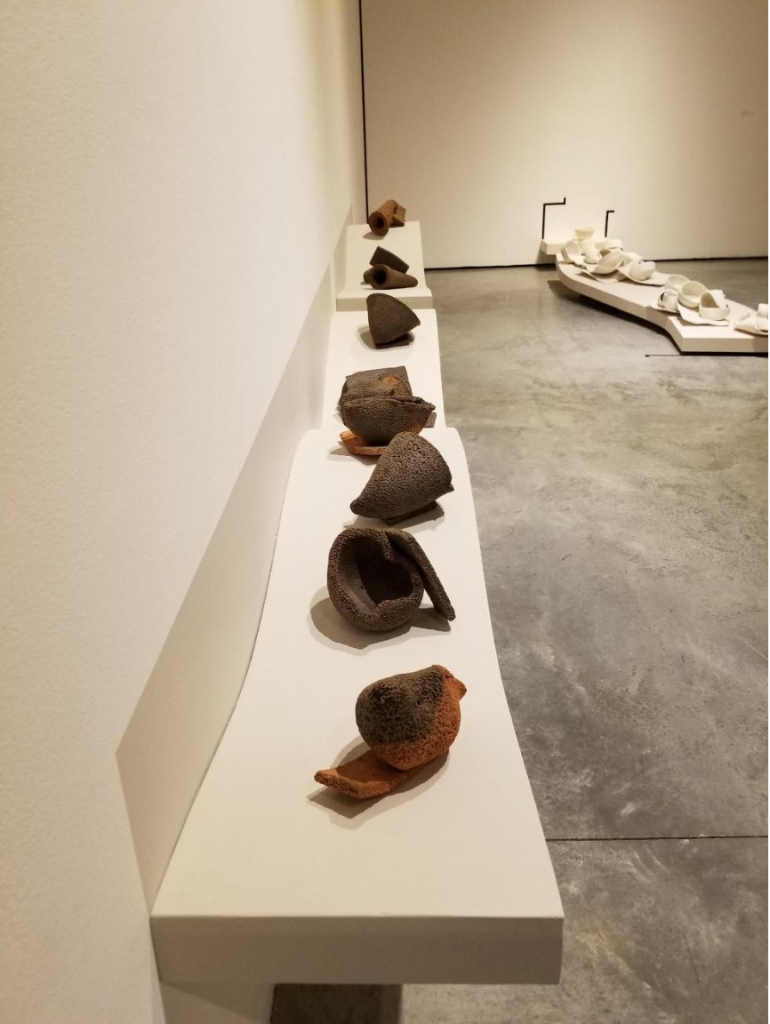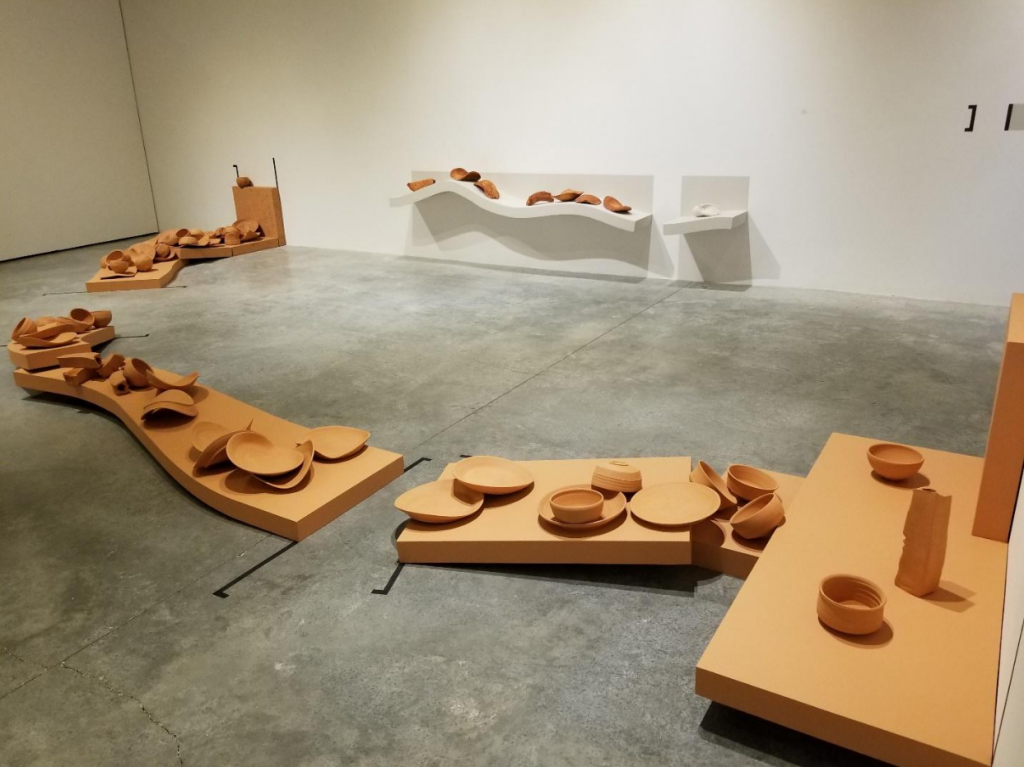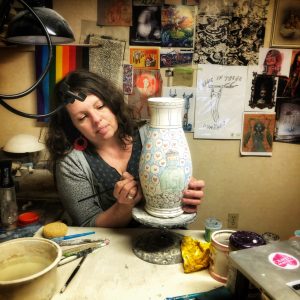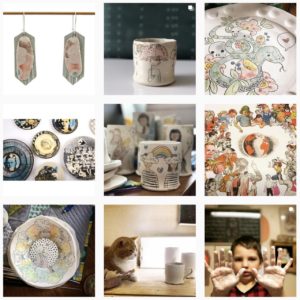Robert Froese’s MFA thesis show Measured Composition was on display at the Illingworth Kerr Gallery April 2-21, 2018. The exhibition consisted of elements of pottery production, wood platforms and shelves, paint, and gaffers tape, in order to draw connections between pottery, sculpture, memory and musical composition.
The ideas of rhythm in craft and visual arts are not a new concept, Elsie Fogerty examined these relationships in her book Rhythm. Fogerty identified three constant factors of Rhythm, the factor of time, the element of force, and the element of space (Fogerty 368). We see all of these elements coming together in Froese’s work.
The show consists of four sculptural compositions, which show evidence of time as Froese works to discover connections in his art and life throughout his MFA. When entering the gallery, on the left you encounter the first grouping of work titled Twelve Tone Study (figure 1); these 12 pieces are displayed on two shelves, curved like a wave. Froese created these works at the beginning of his MFA, and they show an exploration in forced erosion of the clay material. This forced erosion creates a false sense of time, which plays into Fogerty’s idea of a temporal space that only exists out of The Element of Force (Fogerty 368). The forced erosion also speaks to the fundamental understandings of clay as a raw material. Clay itself is a product of erosion and geologic weathering of the surface of the earth (Rhodes 3). The earth itself has gone through significant changes over time, and clay is part of the evidence of a significant amount of time passing. The unique permanence of clay once fired is unlike any other material (“Ceramics: A Fragile History”), and ceramists throughout time have been using this to their advantage. Ceramics in and of itself has helped us understand people and civilizations that are thousands of years old (Cooper, 8). Ceramics helps us say that we are here, and Froese work is no different, its evidence of time and the hand.
The show forces you to view the works displayed at a lower level. Froese invites you to slow down and enjoy looking at his work in the same way that one would enjoy a long walk on a beach. The works Extended Composition/Terra Cotta (figure 1) and White Tone Composition are inspired by beach walks along costal Japan and exhibited on painted platforms placed on the floor. The colors of the platforms mimic the colors of bisque clay—terracotta and a grayish white. The display ignites rhythm, while the gaffers tape helps to influence the viewer to associate these compositions with music; Froese associates classical music and improvisational jazz with these two works. The final piece along the opposite wall titled Walking Octave, acts like a mirror to the opposite wall; this side displays work created near the end of his MFA, and acts as a solemn farewell. The work is displayed on a gently waved shelf, with a single pot on the shortest shelf. This pot acts like a lingering note after a pianist has struck the final key.
The ceramic pots making up Extended Composition/Terra Cotta and White Tone Composition show evidence of being made very quickly; they are unfinished in both their creation and their firing. The expeditiously made pots create a conflicting rhythm with the display, as if two different pulses are at play. The hurried labors of making pots has its own production rhythm, from weighing and wedging the clay, to working on the potter’s wheel, to trimming and altering – each of these steps leave evidence of a hastily made pot created by a skilled potter. The composition of the display has its own rhythm and energy, from the impulse to slow and look down, to the conflicting excitable moments where many pots come together, as if they are hurrying towards the end of the plinth the way an orchestra builds to a billowing crescendo. The Factor of Time and The Element of Space, both help us to find rhythm among these dialectical pots (Fogerty 368).
With Froese’s history of time spent in Japan it is easy to draw connections between his work and wabi-sabi ideologies surrounding handmade work. With wabi referring to a way of life, spiritual path, inward subjectivity, spatial events, or a philosophical construct and, sabi referring to material objects, temporal events and aesthetic ideas (Koren 23). The idea that everything is always “devolving toward, or evolving from, nothingness” (Koren 42) is a poetic analogy for how clay and music or rhythm can come together; the idea itself is very wabi-sabi. The main point of contention that one could argue that Froese’s work is not wabi-sabi, is that wabi-sabi is primarily expressed in the private domain, whereas modern works of art are primarily expressed in the public domain (Koren 26). That these works are on display in a public gallery creates an opposing force, with functional forms we associate with the home on display in a public space. These pots are essentially unusable based solely on their display, and un-finished nature. The coming together of opposites is a strong theme throughout the work.
Robert Froese shows a fundamental understanding of music and rhythm and his works directly references Elsie Fogerty’s theory of Rhythm and visual art. The exhibition had a strong balance between production pottery and wabi-sabi ideologies, and the influence Japan has had on Froese is apparent. Froese’s MFA show successfully tied together many aspects of his life and gave us greater insight and understanding to his process and how they relate to memory. It also apparent that Froese values the mark of making, and we see his hand throughout the exhibition.
Figure 1 Froese, Robert. Twelve Tone Study (Wall), White Tone Composition (Back). 2018, ceramics, wood shelves, wood platforms, paint, gaffers tape, Illingworth Kerr Gallery, Calgary.
Twelve Tone Study was created at the beginning of Robert Froese’s MFA, these works are more finished the compositions found on the floor. These works explore forced erosion of the clay, and are then fired, glazed, and fired to temperature. They are also displayed on curved shelves, which act to almost mirror the opposing wall. White Tone Composition, is similar to Extended Composition/Terra Cotta, being that both work display bisque clay on wooden platforms, however White Tone Composition is shorter, made of white clay and has a different rhythm.
Figure 2 Froese, Robert. Extended Composition/Terra Cotta (Front), Walking Octave (Wall). 2018, ceramics, wood shelves, wood platforms, paint, gaffers tape, Illingworth Kerr Gallery, Calgary.
Extended Composition/Terra Cotta, is part of Robert Froese’s MFA thesis show Measured Compositions, and is about musical composition, rhythm, and memory. This work is placed at ground level to remind the viewer of long walks on the beach. The gaffer tape is to inform us of the musical connection, as the pots make a visual reference to sound, and music. Walking Octave, located on the wall, is displayed on wave shaped shelf, which aids in the beach walk memory. This work was created at the end of his Masters Degree and acts as a solemn farewell, or like the remaining vibrations of a final cord being struck on a piano.
Bio
- 1992
Alisha Marie received her BFA in Ceramics from the Alberta College of Art + Design in 2018, and Level 1 certification in Expressive Arts Therapy in 2013. Working with clay, slip decoration, and ise katagami, Alisha’s practice discusses personal narrative and works to demystify struggles that pertain to mental illness.
Works Cited
“Ceramics a Fragile History”. British Broadcasting Corporation, April 16, 2012.
Cooper, Emmanuel. 10,000 Years of Pottery. Fourth Edition ed., Philadelphia, University of Pennsylvania Press, 2000.
Fogerty, Elsie. “Rhythm.” The Craft Reader. Editor Glenn Adamson, 2010, pp 366-371.
Koren, Leonard. Wabi-Sabi for Artists, Designers, Poets & Philosophers. Point Reyes, California, Imperfect Publishing, 1994, pp. 23-42.
Rhodes, Daniel. Clay and Glazes for the Potter. Revised Edition ed., Radnor, Pennsylvania, Chilton Book Company, 1957.









